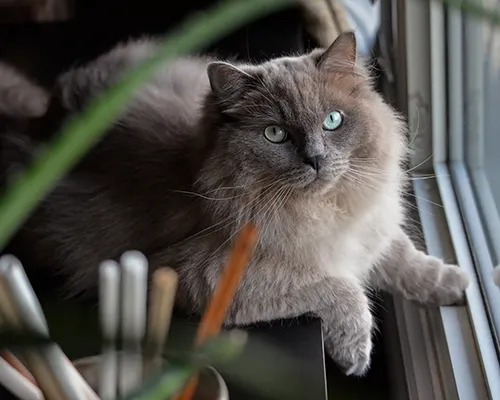April has some pretty fun pet-related holidays and awareness events. We’ve got National Hug Your Dog Day, Cat Lady Day, and Little Pampered Dog Day, to name just a few. There are also a few things on the calendar that aren’t so appealing, such as Heartworm Awareness Month and Hairball Awareness Day. We’ll focus on the latter in this blog. While hairballs aren’t the most fun topic, they are pretty much purr for the course with our feline pals. A local Clarkesville, GA veterinarian offers some information on this below.
What Are Hairballs?
Hairballs have an official scientific name: trichobezoar. These are a rather unsightly downside of what is otherwise a great perk of having a cat: Fluffy’s habit of grooming herself.
Kitties are very clean. Your furry little diva may spend as much as a third of her waking time cleaning herself and making sure that her fur is smooth and clean. Unfortunately, your pet will ingest some of her own fur during this process. Kitties have tiny hairs on their tongues, which are called papillae. This is what gives your pet’s little tongue that sandpaper feel, which you may have noticed if she has ever licked you. Those hairs are angled in a way that helps move food (and fur) down her throat.
You probably already know what happens next.
Fluffy will retch, gag, and then leave a pretty nasty looking mess on the floor. Or on your bed. Or in your shoe. Let’s just say this isn’t the cutest part of having a cat.
How Often Should Cats Throw Up Hairballs?
This is a bit tricky, as it may vary a bit from cat to cat. In a purrfect world, your feline pal would only occasionally have a hairball. However, for most cats, it’s probably more often than either you or your furry friend would like.
That said, it’s not unusual for kitties to have a hairball every week or two. If your kitty is getting them more frequently than that, reach out to your vet: that may be a sign that something is going on. Ask your Clarkesville, GA veterinarian for more information.
How Do I Know If My Cat Has A Hairball?
The main sign? Retching and gagging. Your feline buddy may make similar sounds every time, in which case you’ll probably learn to take note when you hear that telltale sound … and, if you have time, race for something to put down.
Does Wet Food Help With Hairballs?
Wet food doesn’t take as long for cats to digest as dry food. Because everything is moving through Fluffy’s system a bit faster, wet food may help here. That said, it’s not a cure. Also, there are several things to consider when deciding if you want to give your kitty wet food, dry food, or both. Talk to your Clarkesville, GA vet and get some specific advice about your feline buddy’s diet.
What Can I Do To Prevent Hairballs?
There are a few things you can do to help your furry friend out.
Brushing is likely your top option. You’ll be capturing that dead fur with a brush before your kitty swallows it. There are other reasons to consider brushing your feline pal. It’s also good for your pet’s circulation. It’s not a bad purr starter, either: many cats love being pampered. Grooming is also good for bonding.
Here are a few tips on brushing Fluffy:
- Wait until your feline buddy is relaxed. Then, start petting her, going in the same direction as her fur.
- Don’t pull too hard! If your kitty gets knots, and you can’t get them out fairly easily with a detangling brush, you may need to clip them out. Use only round-end scissors. You can also try a plastic letter opener, the type that looks like a credit card with a piece cut out.
- When your kitty decides that she’s had enough, just let her go. Of course, you don’t want to force the issue. Trying to force her to submit is a good way to get scratched! You’ll also find Fluffy much less willing to let you brush her next time.
- You can sweeten the deal by adding lots of attention and praise, and perhaps a yummy treat.
Aside from that, your vet may also recommend a pet jelly, which you can put on Fluffy’s paw. She’ll lick it off when she cleans herself, giving her digestive system a bit of extra help.
Unless your vet objects, you can offer your kitty an occasional can of tuna or sardines as a treat: the oil in it can help a bit.
There are also hairball preventative products. As the name suggests, these help prevent hairballs. However, be sure to ask your vet before offering supplements or products. Not every product is going to be suitable for all kitties.
Making sure Fluffy is staying hydrated is also important. You may want to get her a little kitty fountain. Many cats prefer to drink running water!
Last but not least, keeping your cat inside can also help with this. Cats that don’t go out are less exposed to seasonal weather changes that trigger heavy shedding. They also won’t roll around in dust and dirt. This is also better for your kitty’s safety. Fluffy will be much safer staying in, where she will be protected from things like cars, wild animals, and increment weather.
Ask your vet for specific advice.
What Happens If My Cat Can’t Throw Up Her Hairball?
Hairballs occasionally can lead to very serious medical problems. If the hairball gets lodged in your pet’s system, and she can’t throw it up, she could be at risk of major internal issues. Intestinal blockages and ruptures are definitely not something to take lightly: they are not only extremely painful, they can be life-threatening. Keep an eye out for signs that there is something more going on than the usual run-of-the-mill hairball.
Some of these include the following:
- Dry heaving
- Excessive vomiting
- Bloody or frothy vomit
- Diarrhea
- Constipation
- Lack of Appetite
- Withdrawal
- Behavioral Changes
- Coughing
If you notice any of these, contact your vet clinic right away.
Some of these issues may be indicative of other medical issues, so it’s very important to find out what is going on as soon as possible.
Do Cats Deliberately Leave Hairballs In Certain Spots?
The jury is out on this one. We can’t officially poll our feline friends, but we wouldn’t exactly be shocked to find that Fluffy does sometimes make a statement.
Do Longhaired Cats Get More Hairballs Than Shorthaired Ones?
They can. Maine Coons and Persians, for instance, are purrticularly prone to them. Of course, sometimes cats with short fur also have very thick coats, which can also make them prone to developing hairballs.
If your feline buddy has long hair, we’d suggest brushing her regularly. This will also help prevent snarls and tangles. You may need to get a special de-tangling brush, particularly if Fluffy is prone to getting hairballs.
Conclusion: While hairballs aren’t the best part of having a cat, they are not unusual. However, it is important to take steps to reduce the amount of hairballs your feline pal gets, and also to know the warning signs that something more serious is going on.
Schedule An Appointment At Your Clarkesville, GA Veterinary Clinic
Do you have questions about your kitty’s health or care? Please feel free to contact us at any time. As your local Clarkesville, GA pet hospital, we are here to help!







!Social Media Icons